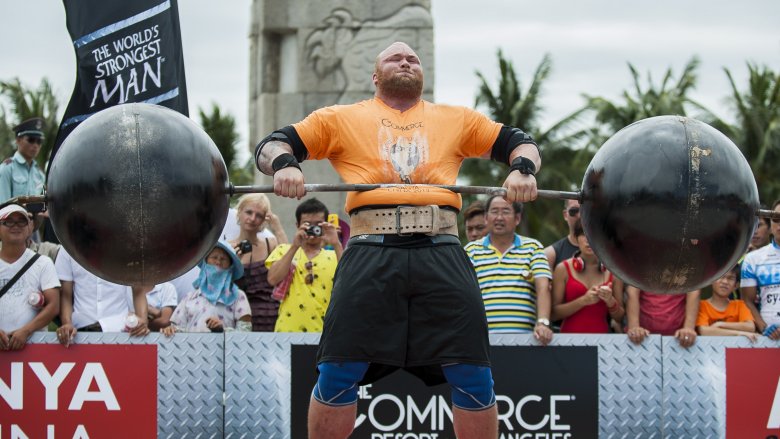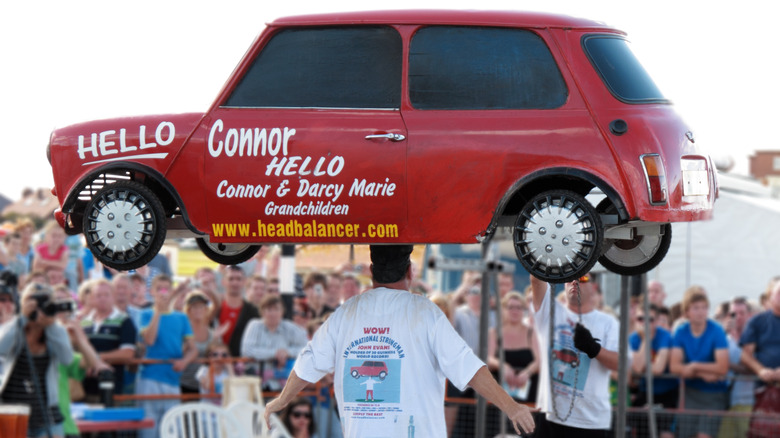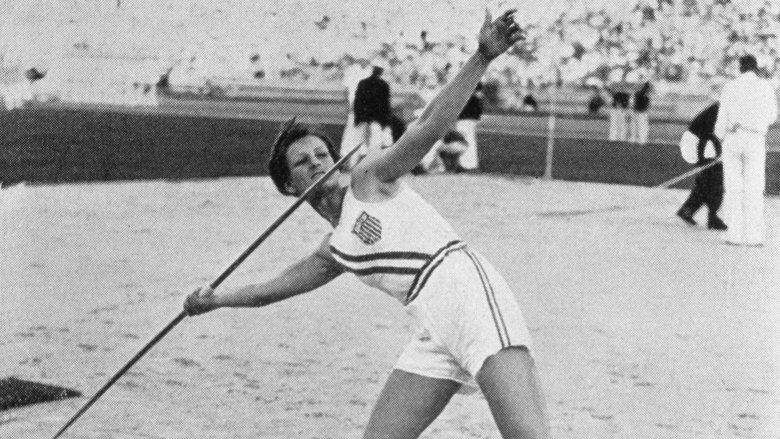The Most Freakish Feats Of Athleticism
It's one thing for an athlete to make Sportscenter's Top 10, but it's quite another to transcend athleticism to the point where people wonder if you're actually human. The following people are the latter, having performed some freakishly amazing athletic feats that'll make you think twice about bragging about that one home run you hit in high school.
John Evans
If it exists, and it's heavy, John Evans can almost certainly balance it on his head. The famed strongman takes his balancing act a step further by walking around with the heaviness on his head and keeping it there for at least ten seconds.
In addition to the Guinness World Record set in the above video, where Evans balances a 352-pound mini car on his head for 33 seconds, Evans has balanced countless other objects, for no real reason other than to prove that he can, and you can't. According to his website, Evans has balanced 98 milk crates, 548 footballs, two girls on bicycles (at a total combined weight of 374 pounds), a guy drinking while sitting on a bed of nails, ten tires, two bunk beds, 300 loaves of bread, 1,710 eggs (all in their cartons, because even he's not that good), and two cement mixers, among many other feats.
While this is all incredibly impressive, and definitely something most of us couldn't approach in our wildest dreams, it does make you wonder how something like this even begins. Was Little John just bored one day and decided, "hey, I'm going to balance my video game collection on my head," found it was easy as pie, and went from there to the record books? Probably.
Alex Honnold
Alex Honnold has absolutely no fear of anything, even when he absolutely should. Case in point, he should have been way too scared to perform a ropeless, gearless solo-climb of Yosemite Park's El Capitan — a 3000-foot wall of smooth, almost-totally-vertical rock in California. But not only was he unafraid to attempt the climb, he actually completed it. That's a good thing, given that the alternative was plummeting to his doom.
According to National Geographic, nobody had ever before scaled El Capitan "free solo," which means leaving your ropes and gear at home, and trusting your hands and feet to not betray you to your death. Then, along came Honnold. In June 2017, he arrived at El Capitan with nothing but sticky-soled climbing shoes, chalk to dry his hands, and more courage than a million firefighters. Over three hours and 56 minutes, Honnold scaled El Capitan, reaching the summit and basking in what has to be peak of his climbing career. Even scaling the tallest building in the world, the Burj Khalifa, would prove anticlimactic — that thing peaks at a mere 2717 feet.
Amazingly, if you talk to Honnold, he'll claim his level of fear isn't any lower than yours. As he told National Geographic in 2016, his secret is that he has a higher awareness of death than the average person. He knows he's going to die eventually, a realization that inspires him to take more risks and live his life to the fullest. For most of us, our version of YOLO involves enjoying two Big Macs instead of one, but more power to this guy for choosing to tackle the impossible instead.
Hafthér Björnsson
When you write a character nicknamed The Mountain, you want to ensure the actor who plays him fits the part. Well, Game of Thrones hit the nail on the head when they got one of Iceland's greatest strongmen, Hafthér Björnsson, to portray the gigantic, monstrous, head-squashing Mountain. Before the books even existed, Björnsson was made for that role.
Lest you think his strength isn't real — that he looks big but there's nothing behind those muscles — he owns a world record that'll shut you up completely. As reported by People, in 2015 he set out to break a record allegedly held for over 1,000 years — by a viking named Orm Storolfson. To do so, Björnsson needed to carry a giant log on his back for more than three steps. That doesn't sound too hard, except the log weighed 1,433 pounds. Also, according to the legend, Storolfson reportedly only walked three steps with it on his back. Björnsson, meanwhile, walked five steps. If any of you tried that, you'd take zero steps, at least until the hospital cleared you to begin physical therapy and learn how to walk again.
Björnsson probably isn't done yet. After all, there are still entire trees that need lifting. Hopefully he's shoveling calories into his maw as we speak, gaining enough strength to haul a Redwood across, at the very least, Rhode Island.
Babe Didrikson
It's one thing to be great in a sport. It's another to be freakishly great. It's yet another thing to be freakishly great at all the sports. Babe Didrikson was such a person, excelling at basically every sport she knew existed. Also, she did this in the 1930s, when the most athletic thing women were expected to do is run from the kitchen to the living room so her husband's meal was served on time.
According to ESPN, Didrikson dominated sports as diverse as basketball, baseball, tennis, swimming, track, diving, boxing, volleyball, bowling, billiards, cycling, and many more. As sportswriter Grantland Rice said of her, "you are looking at the most flawless section of muscle harmony, of complete mental and physical coordination, the world of sport has ever seen."
She qualified for five different events at the 1932 Olympics, even though the incredibly archaic rules of the time said women could only be in three. Of those three, she won two gold medals, set a world record in hurdling, and lost out on a third gold, in the high jump, over a ridiculous rule. (Back then, your head wasn't supposed to clear the bar first. That's not a rule anymore, and it almost certainly never should have been). When she moved on to golf, she destroyed that as well, winning 17 out of 18 tournaments before going pro. On the side, she would do things like play 17 sets of tennis in one day, just for funsies.
In 1953, Didrikson learned she had inoperable cancer. She responded to that by returning to golf a year later and winning the US Women's Open by an unreal twelve strokes. Even while facing death, she was better than basically every athlete ever.
Javier Sotomayor
What's the highest you've ever jumped? Six inches? A foot, maybe? Either way, high jumper Javier Sotomayor blows you out of the water. In fact, he may have reached the literal limits of human jumping ability, so don't even try topping him.
On July 27, 1993, Sotomayor set a world high-jump record, with an positively fantastical 2.45-meter leap. For those of us who know nothing of the metric system, that's 8.04 feet. The man could jump over most basketball players, and probably many a grizzly bear. Roughly 25 years later, nobody's been able to break his record. Some have come close, but no one has managed 2.46 meters. That may well be because nobody can.
According to Red Bulletin, the human body might not be physically capable of jumping much higher than Sotomayor, if at all. Famed long-jumper Dick Fosbury thinks that we'll soon find someone who can jump 2.5 meters, or 8.2 feet. But thus far, it's proven easier said than done. We always hear about superheroes reaching "peak human conditioning" — in the case of Sotomayor, we may have a legitimate real life Batman.
Babu Chiri Sherpa
It's hard enough to scale Mount Everest normally. To do it without bottled oxygen, however, is practically asking the mountain to add you to its collection of frozen bodies that will never be claimed. This makes the story of Babu Chiri Sherpa all the more amazing.
In the spring of 1999, Chiri reached the summit of Everest, as he had done many times before. Also like many times before, he had no bottled oxygen, despite Everest's summit being far above "the Death Zone" (the point around 23,000 feet where oxygen gets so thin the body actually begins to suffocate and die). But in 1999, not only did he breach the Death Zone, he actually stayed there for 21 hours. That's something the human body simply should not do, so it's no surprise he set a Guinness World Record for the longest time spent on the summit without bottled oxygen. It's also no surprise nobody's broken it since.
Sadly, Chiri died on Everest in April of 2001, but not because he tried to make it a full 24 hours or anything. His death was surprisingly pedestrian — he was resting at Camp 2 (21000 feet up, far below the death zone), apparently went to take some pictures, and fell into a crevasse to his death.
Gethin Butler
Compared to the United States, Great Britain isn't very big. So bicycling from the north end to the south (a feat creatively titled End-to-End) might not sound like much of a deal. But you'd be wrong — the trek from Land's End to John O'Groats covers 969 miles, roughly a third of the way across the US. As you might expect, most don't make the trek, and those who do take their sweet time and then probably give up. Deloitte Ride Across Britain, a company that sells End-To-End packages, advertises finishing times ranging from five days to two years (the latter being for when you're feeling lazy but also want to say you accomplished something).
In September 2001, however, long-distance cyclist Gethin Butler did the End-To-End in 44 hours. Yes, in less than two days, a man was able to bike nearly 1,000 miles. According to Guinness World Records, he actually completed 509.3 miles before hour 24, meaning the guy who biked 460 miles in a day was actually taking it easy.
Don't expect this amazing feat to be topped anytime soon. Since the gold standard now is to complete the journey in less time than it takes to binge-watch Game of Thrones, it's very likely Butler's record will stand for awhile.
Diana Nyad
Swimming from Cuba to Florida covers about 100 miles of water. It's also basically impossible to do, thanks to things like massive amounts of salt water, and sharks who will probably find you annoying, intrusive, and delicious. But try telling that to former Olympian Diana Nyad, who in 2013 became the first person to complete the swim without a shark cage around her. (Yes, there are shark cages you can swim in, and now you know what to ask Santa for this Christmas.)
Diana did it without any cage all, plus she was 64 years old at the time. Perhaps even more impressively, this was the fifth time she had tried this. Over the course of 35 years, she had failed four attempts to make it from Cuba to Florida, despite using a shark cage some of the times. This time, though, she ditched the cage, swam alone, and managed a feat even 20-somethings haven't pulled off, never mind 60-somethings.
But don't think it was easy breezy — poor Nyad suffered throughout. As she told CNN, "all the experience I have ... I never knew I would suffer the way I did ... for 49 hours the wind just blew like heck, and it was rough." She even found herself throwing up mid-swim, since she had ingested way too much salt water. And yet she kept going, because she didn't want to fail a fifth time. She most certainly didn't, and in doing so proved two things: you're never too old to chase your dreams, and maybe sharks aren't that big a deal after all.
Brett Melson
It's hard to hit a hole-in-one in regular golf — when it does happen, it's usually a smaller hole, maybe 200 yards or so. But occasionally, somebody strides up to a regular, 400-yard-plus hole and decides to own it. In December 2006, golfer Brett Melson did just that, recording the longest recorded hole-in-one in history, acing a 448-foot hole like a Par 2 windmill at Crazy Dave's FunTime Putt-Putt Land.
According to the Honolulu Advertiser, Melson didn't actually hit the ball across all 448 yards — he took a shortcut measuring "only" 373 yards. But that's still an amazing shot, so much so that Melson initially couldn't believe he had done it. As he said, "I knew the ball had reached the green, but ... we couldn't find it. We looked for 15 minutes and I was totally shocked to find it at the bottom of the cup." That's understandable, since perfectly hitting a ball for that much distance ordinarily shouldn't happen. Plus, that hole's rated by the San Diego Golf Academy as the toughest hole on the course. Also, that course — Oahu, Hawaii's Ko'olau Golf Club — is apparently seen by many golfers as the toughest course in the world. Melson managed the sporting equivalent of speedrunning the most frustrating part of Dark Souls, with no damage.
It's even more amazing because Melson was a San Diego Golf Academy student at the time, not some grizzled old pro. No stories seem to exist of any golf career after this ace, so presumably he realized he had achieved perfection and moved on to other challenges. So if someone ever, say, hits a baseball clear across the city, it might be him.
Richard Albero
Richard Albero is better at walking than you, and he's 65. Just let that sink in.
In 2015, Albero decided to raise money for the Wounded Warrior Project, in memory of his nephew who died during the attacks of 9/11. He did so by vowing to walk from home plate at Steinbrenner Field (the New York Yankees' Spring Training home in Tampa, Florida) to home plate at Yankee Stadium, a 1,150-mile trek that would tucker out even the most avid walkers. Albero not only did it, he did it in 86 days. Doing some quick math, that averages out to over 13 miles a day, with no days off. That's ridiculous, and it's a testament to his fitness and drive that his legs didn't fall off after a week. He did stop at hotels to sleep each night, and people did drive him there, but that doesn't exactly make a 65-year-old walking 13 miles a day, every day, any less impressive.
This athletic feat worked on a fundraising level too — according to MLB.com, Albero raised over $27,000 for Wounded Warriors, making his challenging expedition (he ran out of water early on in Jacksonville, and had to soak his feet each day simply to keep going) worth it. He flat-out admitted he never wants to do this kind of walk again, but who can blame him? You're probably exhausted just thinking about it.





